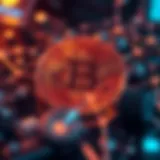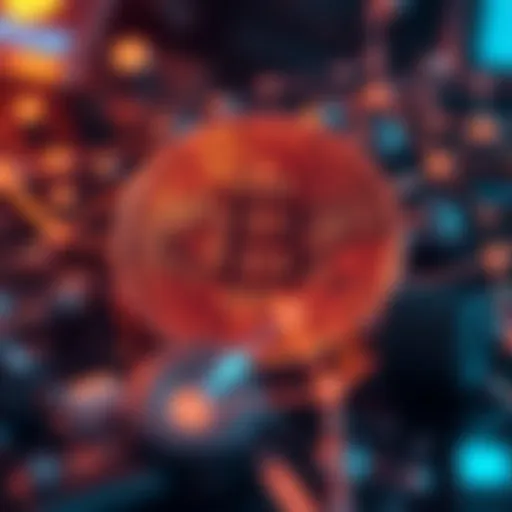The Pioneers of Digital Art: Best NFT Artists Today
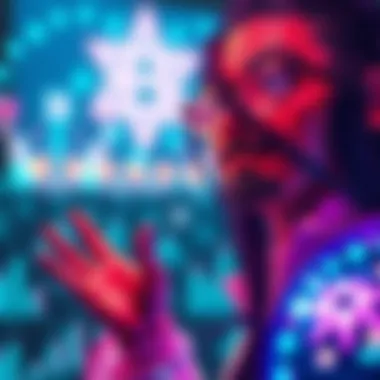
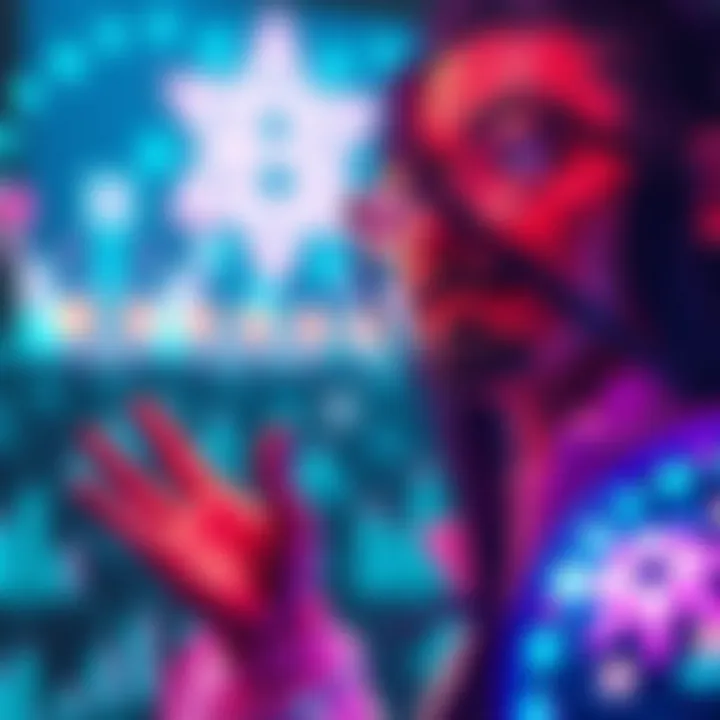
Intro
In recent years, the emergence of non-fungible tokens (NFTs) has stirred up substantial discourse in various circles, especially among artists and investors. NFTs, which represent ownership of unique digital assets, have reshaped how art is created, bought, and sold. While collectors and tech enthusiasts eagerly flock to this new arena, artists are not just observers but are blazing trails within this expansive digital landscape.
This article unpacks the world of NFT artistry. We'll explore influential artists who are at the forefront of this movement, examining their distinct styles and contributions. More than mere digital creations, their work stands as testimony to the vast capabilities of technology and creativity. We'll also delve into how their efforts impact both the artistic community and the broader digital economy, providing insights that illuminate the significance of these artists in today’s world.
By diving deeper into their methodologies and creative inspirations, you’ll gain a clearer picture of how these pioneers are not only redefining art but also participating in a paradigm shift that invites fresh perspectives on value and ownership in the digital age.
Let’s embark on this journey to understand the trailblazers who are shaping the future of art through the lens of NFTs.
Understanding NFTs and Their Impact on Art
The digital landscape has witnessed a seismic shift with the introduction of non-fungible tokens, commonly known as NFTs. Understanding NFTs and their impact on the art world is not just about grasping a technological marvel; it's about recognizing a new paradigm in creative expression and ownership. This section aims to illuminate the tremendous implications that NFTs hold for artists, collectors, and the broader art community.
What are NFTs?
Non-fungible tokens are a novel type of digital asset that represents ownership of unique items or content on a blockchain. Unlike cryptocurrencies such as Bitcoin or Ethereum, which are fungible and can be exchanged for one another, NFTs are distinct. Each token embodies a specific digital file—whether it’s artwork, music, or collectibles—making it irreplaceable. For artists, NFTs provide a revolutionary means to monetize their creations. Through platforms like OpenSea and Rarible, creators can directly sell their work to collectors without relying on traditional galleries or auction houses.
The Evolution of Digital Art
In the annals of art history, digital art has carved its niche over the past few decades, transforming from a marginal form of expression to a mainstream phenomenon. Initially, digital artists relied on conventional methods for distribution, often facing skepticism regarding their legitimacy. However, the rise of technology and the internet drastically changed this narrative. With the advent of NFTs, digital art has finally gained the validation it deserves. Artists can now harness the power of platforms to showcase and sell their work, drawing in audiences across different cultures. Today, diverse styles—from pixel art to generative art—flourish within this ecosystem, enabling creators to push boundaries in ways unimaginable a generation ago.
How NFTs Revolutionize Ownership
NFTs redefine ownership by allowing digital artists to sell their work with verifiable authenticity. When a buyer acquires an NFT, they gain not only the digital file but also a certificate of ownership that lives on the blockchain. This transparency minimizes issues related to forgery and misattribution, which have plagued the art world for centuries. For collectors, this means having tangible proof of ownership that can be transferred and traded with ease. Furthermore, creatives can program royalties into their NFTs, ensuring they earn a percentage from future sales, which incentivizes them to invest in their own artistic development.
The Role of Blockchain in Authentication
Blockchain technology underpins the entire NFT ecosystem, providing a secure, decentralized method for verifying authenticity and ownership. Each NFT's transaction history is recorded on the blockchain, offering an immutable ledger that can be accessed at any time. This aspect is crucial, as it addresses the longstanding issues of counterfeiting and provenance that have troubled traditional art forms. As a result, collectors can confidently invest in digital artworks, knowing that they are acquiring a verified and unique piece. Some might argue that such authentication is straightforward, yet its impact on maintaining the integrity of art cannot be overstated.
"In the new world of digital art, the blockchain isn’t just a tool; it's a lifeline."
Opportunity and challenges abound in the NFT space. While these tokens enable a robust market for artworks, not everyone has embraced them wholeheartedly. Yet, understanding how NFTs bridge the gap between digital art and ownership can provide valuable insights for artists and collectors navigating this ever-evolving realm.
The Ecosystem of NFT Artists
The landscape of NFT artistry is not just a mere blip on the radar of the art world; it represents a thriving ecosystem filled with creators, collectors, and technology enthusiasts. This section digs into what constitutes this ecosystem, how it operates, and the potential benefits and challenges within it. Understanding this framework is crucial, as it lays the foundation for appreciating the unique qualities and impacts of each artist in the NFT realm.
What Defines a Great NFT Artist?
Identifying a standout NFT artist isn't solely about the quality of their work; it's also about their innovation, originality, and ability to connect with an audience. A great NFT artist typically possesses a distinct artistic voice, often characterized by:
- Creativity: Art that pushes boundaries or introduces new styles.
- Engagement: Meaningful interaction with fans through social media or community platforms.
- Consistency: A reliable output that reflects their unique style while sometimes experimenting with new techniques.
Moreover, the scope of an artist's influence can also elevate their status within this ecosystem. An artist may not always hit the high notes in traditional evaluations of art, yet their ability to leverage technology and connect with collectors surely plays a pivotal role in their acclaim.
Understanding Different Artistic Styles
The NFT scene is a melting pot of diverse artistic styles, ranging from intricate digital illustrations to more abstract interpretations. Here are a few notable styles commonly seen:
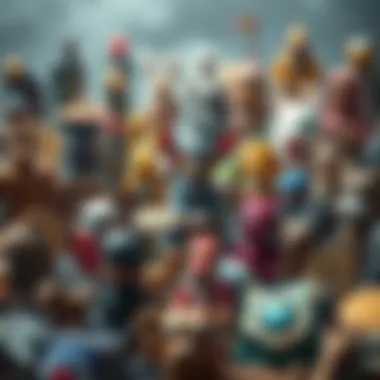
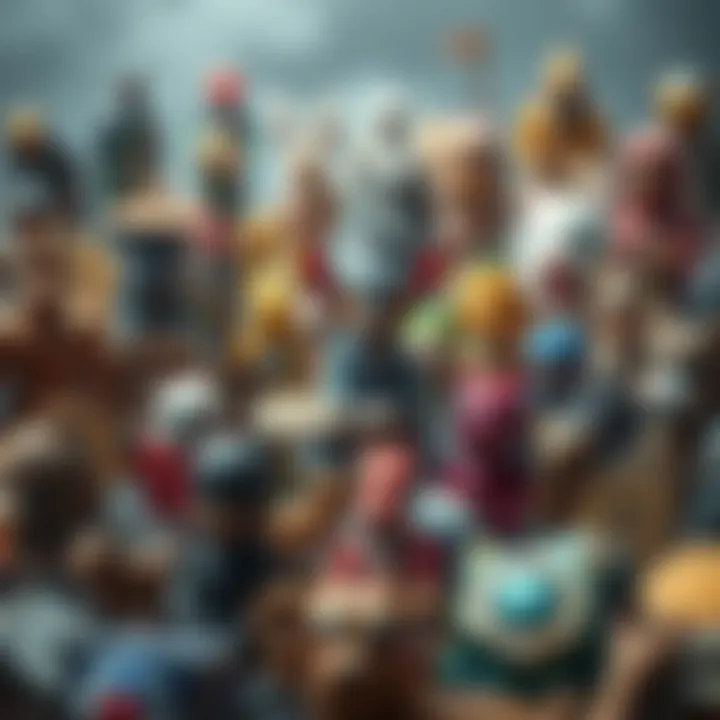
- Generative Art: This involves creating algorithms that produce unique pieces, offering infinite variations of a theme, such as projects by Art Blocks or Raf Grassetti.
- Pixel Art: Known for its nostalgic 8-bit aesthetic, it connects with audiences who appreciate retro games and early digital artistry.
- 3D Models & Animation: Artists like Beeple have taken this to the next level by crafting immersive environments that resonate particularly well in virtual spaces.
- Abstract Art: Some creators focus on the emotional response to color and form, often creating pieces that defy straightforward interpretation.
Understanding these varied approaches not only enriches the viewer’s experience but provides insight into how each artist uniquely contributes to the NFT ecosystem.
The Influence of Social Media on Artists
Social media platforms serve as the lifeblood for many NFT artists, acting as both a portfolio and a marketplace. They help bridge the gap between creators and collectors, making engagement straightforward and instantaneous.
- Direct Promotion: Artists can share teasers of their upcoming projects or interact with their audience, offering a behind-the-scenes look into their creative process.
- Building Community: Artists cultivate a following by establishing a sense of belonging among their fans and collectors. This relationship often motivates sales and increases their visibility.
- Feedback Loop: Real-time feedback from followers helps artists refine their work. It's not uncommon for creators to adjust their styles based on the responses they receive online.
Social media not only amplifies an artist's reach but also democratizes the art world, allowing unknown talent to catch the eye of discerning collectors. Without a doubt, the symbiotic relationship between NFT artists and social media platforms is vital to understanding the overall ecosystem.
In essence, the ecosystem of NFT artists thrives on creativity, engagement, and a willingness to adapt to new technologies and social media dynamics. It is this blend of factors that contributes to the profound impact these artists have on the contemporary art narrative.
Showcasing Prominent NFT Artists
Showcasing prominent NFT artists is essential for understanding the evolution of digital art in the modern context. As non-fungible tokens gain traction, the artists behind these digital masterpieces have not only transformed how we perceive art but have also redefined ownership and value in the creative world. By spotlighting these pioneers, we can appreciate their unique styles and contributions while recognizing their influence within the broader landscape of art and commerce.
Prominent NFT artists often do more than create; they challenge norms, pushing boundaries of artistic expression. Their works serve as a commentary on society, technology, and the shifting paradigms of ownership. Each artist brings their flair, be it through visual storytelling, audacious conceptual frameworks, or groundbreaking techniques. Consequently, by examining their impact, we learn much about the dialogues happening around art today.
Beeple: Pioneering Digital Art
Beeple, known in reality as Mike Winkelmann, has emerged as a trailblazer in the NFT space. His artwork, often described as visually vibrant and intricately detailed, encompasses a myriad of styles and themes. He gained unprecedented recognition when his piece "Everydays: The First 5000 Days" sold for a staggering $69 million at Christie’s auction in March 2021. It was a watershed moment, signaling that digital art could command prices traditionally reserved for classic masterpieces.
Beeple's work often critiques contemporary culture, pushing viewers to reflect on the digital age's implications. Notably, he blends familiar motifs with dystopian elements, a juxtaposition that resonates widely across audiences. The significance of his approach extends beyond aesthetics; it poses crucial questions about what constitutes ownership in the digital realm.
Pak: Minimalism Meets Complexity
Pak represents a unique fusion of minimalism and complexity in digital art. The artist’s identity is shrouded in anonymity, which adds an intriguing layer to their work. Their pieces often feature geometric forms that, while appearing simple at first glance, invite deep exploration and interpretation. Pak's series, like "The Fungible," exemplifies this idea, eliciting discussions about scarcity and art valuation in the digital space.
Moreover, Pak's work leverages cutting-edge technologies to engage the audience in participatory experiences. By incorporating interactive elements, viewers are invited to become part of the art, transcending traditional passive observation. This aspect enriches the art community, encouraging discussions about the role of artists and collectors alike.
Mad Dog Jones: A Fusion of Tradition and Innovation
Mad Dog Jones, a Canadian artist whose real name is Michah Dowbak, embodies a blend of traditional artistry and modern digital techniques. His creations mix elements of Japanese culture, cyberpunk aesthetics, and intricate illustrations, making for a dynamic visual experience. Jones elevates storytelling through immersive narratives woven into his pieces, transforming them into more than mere visuals.
His notable work, "Replicator," sold for over $4 million, underscoring the monetary appeal of NFT art. However, the significance of Jones extends beyond financial metrics. His art serves as a bridge between heritage and future, inviting viewers to explore themes that resonate deeply in our current socio-political climate.
Xcopy: Distorting Reality through Art
Xcopy is an artist renowned for distinctive style, marked by a mix of dystopian themes and vibrant visuals. Their works frequently explore the darker facets of the digital experience, offering a perspective that is both unsettling and thought-provoking. The use of glitch effects adds a level of unpredictability, captivating viewers and challenging them to reconsider their relationship with the digital world.
Like Beeple, Xcopy has garnered impressive sales, with some pieces fetching hefty sums. Yet, the artist’s true contribution lies in their ability to provoke discomfort, pushing viewers to confront the duality of reality and virtual existence. This positions Xcopy as a crucial figure within the dialogue surrounding NFT art—inviting a continuous reflection on its place in contemporary life.
The contributions of these prominent NFT artists illustrate not just their individual talents but the collective evolution of digital art as a pivotal segment of today’s creative economy. Their works inspire conversation, bridge gaps between traditional and digital mediums, and expand the possibilities of what art can be.
The Economic Implications of NFT Art
The emergence of NFTs has dramatically reshaped the landscape of art and technology. For artists, curators, collectors, and investors alike, understanding the economic dynamics of this new market is crucial. As NFT artworks gain traction, their implications on traditional economic structures warrant close examination. In this section, we’ll unpack the market trends, address the potential of investing in NFT art, and pinpoint the roles of auctions and online platforms in navigating this evolving terrain.
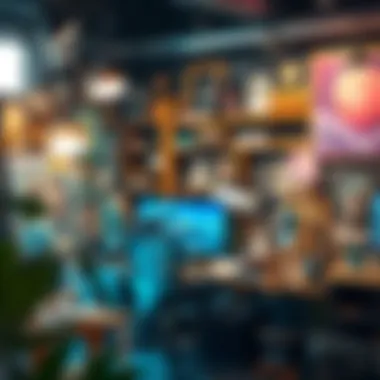

Market Trends and Valuation
The NFT market is akin to a rollercoaster ride; it piques interest not just for its novelty but also for its rapid fluctuations. Right now, figures suggest that the NFT market could reach a valuation of tens of billion dollars. The pandemic acted as a catalyst, accelerating the digital transformation and propelling virtual art into the spotlight.
Some important trends to keep an eye on include:
- Diversification: Traditional artists are branching out from physical mediums to digital formats, leading to an increased overlap between established art circles and progressive digital platforms.
- Rarity and Scarcity: Scarcity is a key keyword here. The non-fungibility of NFTs ensures each piece is unique, driving demand and consequently the price. The more exclusive an artwork seems, the higher its market value can climb.
- Marketplaces: Platforms such as OpenSea and Rarible are constantly evolving, offering new functionalities and expanding access to a broader audience. This has democratized the art-buying experience, allowing anyone with an internet connection to participate.
These trends have not only changed how art is viewed but have also redefined its valuation methods. Traditional appraisals often relied on historical significance or artist reputation, while NFT valuations tend also to factor in community engagement and the ecosystem's buzz.
Investing in NFT Art
For investors, stepping into NFT art can be as thrilling as navigating a labyrinth. It's essential to approach this field with a strategy, akin to choosing stocks or cryptocurrencies. Many investors are not just looking at potential monetary gains; they are also fascinated by the technology underpinning NFTs and their socio-cultural implications.
Key considerations include:
- Researching Artists: Like any investment, getting to know the artist and their body of work can pay dividends. Follow their social media, engage with their community, and understand their previous sales history.
- Diversifying Your Portfolio: It may be wise not to put all your eggs in one basket. Investing in various mediums and styles can help mitigate risks associated with market volatility.
- Understanding Market Timing: The art market is often influenced by high-profile sales and public perception. Keeping an ear to the ground can help investors identify when to buy or sell.
It’s important to note that while the rewards can be high, the risk is equally pronounced. Speculative bubbles can form quickly, making it essential for investors to tread with caution and due diligence.
The Role of Auctions and Platforms
Auctions play a pivotal role in the NFT ecosystem, akin to the auction houses of the traditional art world. Prominent auctions have become battlegrounds for high-stakes bidding wars, showcasing the fusion of digital art and economic power. - For example, the sale of Beeple’s ‘Everydays’ for $69 million at Christie’s marked a seismic shift, catching the eyes of mainstream media and collectors alike.
Working through platforms is crucial, as these digital marketplaces serve as both gallery and salesroom. They offer:
- Accessibility: Anyone can create a digital wallet and start collecting or selling NFTs. This lowers the barrier to entry, allowing diverse voices to join the conversation.
- Community and Networking: Many platforms emphasize community engagement and provide tools for artists and collectors to connect with one another, turning virtual spaces into thriving hubs.
- Innovations in Bidding: Novel auction strategies, such as timed auctions and reserve prices, enable more flexible transaction methods and can influence buyer behavior in real-time.
Challenges Facing NFT Artists
Art is not just about creation; it also involves navigating a maze of challenges, especially in the rapidly evolving world of NFTs. These challenges shape the experiences of digital artists, influencing everything from their creative processes to their financial outcomes. In this section, we delve into critical issues NFT artists face today, highlighting the importance of understanding these challenges for potential investors and the broader art community.
Copyright Issues and Ethical Concerns
One of the most pressing issues for NFT artists is the murky waters of copyright. With digital art being so easy to replicate, artists are often left in a lurch over the ownership rights of their work. When someone mints an NFT of art they don’t own, it raises serious ethical questions. Many artists find themselves fighting to prove the originality of their works, a task that can be daunting and costly.
- Infringement Risks: With the open nature of blockchain technology, tracking down infringement can feel like finding a needle in a haystack. As the saying goes, a thief may take a moment to act but can steal a lifetime of work. Legal frameworks around copyright in the NFT space are still developing, leading to uncertainty for creators.
- Enforcement Difficulties: Even if artists can prove their work has been misused, enforcing their rights can be an uphill battle, often requiring legal expertise. This strained reality highlights the need for a more robust framework for protecting digital art.
Environmental Impact of NFTs
The environmental footprint of NFTs often casts a long shadow over their bright potential. NFTs typically rely on blockchain platforms—especially those like Ethereum—which currently use energy-intensive proof-of-work models. The energy utilized can compare to that of small countries, raising eyebrows and questions about sustainability.
- High Energy Consumption: A study from the University of Cambridge noted that Bitcoin and Ethereum alone consumed as much energy as the entire nation of Argentina. For many artists, this poses a dilemma: how to pursue innovation while remaining conscientious about the planet.
- Alternative Solutions: Some platforms are beginning to embrace proof-of-stake systems or other greener alternatives, yet they remain in the minority. Artists often face the ethical dilemma of whether to mint NFTs given their environmental impacts, which may alienate eco-conscious collectors.
Market Saturation and Competition
As the NFT market booms, aspiring artists dive in, hoping to ride the wave. However, the rapid influx of new talent leads to overwhelming competition, making it harder for individual artists to stand out. Being an overnight success is not as easy as it sounds.
- Essential Differentiation: Artists need a unique voice or style to differentiate themselves from a sea of creators. Simply following trends may not ensure visibility or sales. The industry's pace requires constant reinvention—a tough ask when creativity also requires time and space to breathe.
- Chasing Hype: Amid market saturation, artists often feel pressured to chase the latest trends or fads, risking their authenticity for short-term gains. The pressure can lead to burnout, and while riding the wave of popularity can be tempting, maintaining artistic integrity is crucial.
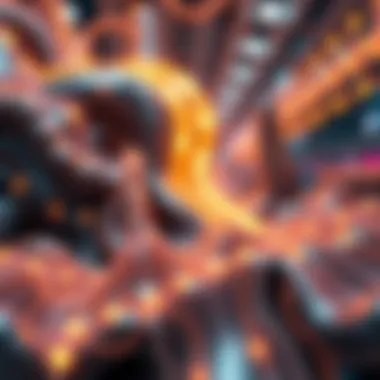
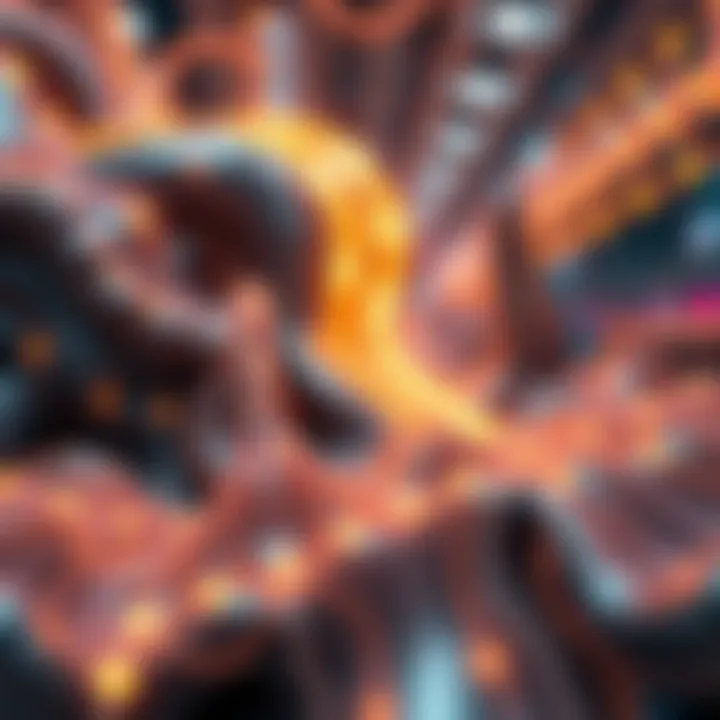
"In a saturated market, staying true to one's artistic vision amidst competition can often feel like searching for a diamond in the rough."
Navigating these challenges may be difficult, but understanding them is crucial for interested stakeholders in the NFT space. They not only shape the landscape of digital art today but will also influence its future direction and relevance.
The Future of NFTs in the Art World
The realm of NFTs has spurred considerable excitement not only among artists and collectors but also within the broader cultural landscape. As the digital art scene continues to evolve, NFTs aren't merely a passing fad; they herald a significant shift in how art is created, consumed, and valued. Understanding the future of NFTs is integral for stakeholders across the spectrum—from investors seeking to navigate the emerging economy to educators preparing the next generation of artists. The broader implications of this shift echo through various fields, providing fertile ground for innovative ideas and strategies.
Projected Trends and Innovations
Looking ahead, the NFT landscape promises a tapestry of trends that will redefine artistic expression and economic interaction. One notable trend is the shift toward more sustainable practices in the NFT space. Artists and platforms are recognizing the environmental concerns surrounding blockchain technology and are striving to adopt eco-friendly solutions. This might involve utilizing more energy-efficient blockchains or engaging in carbon offset initiatives.
Moreover, the incorporation of smart contracts will continue to play a crucial role in how artists retain control over their work. For instance, automatic royalty payments on subsequent sales of artworks could ensure that creators benefit from the long-term appreciation of their pieces. Thus, artists are not only creators but also entrepreneurs with vested interests in the value of their art over time.
Furthermore, there is growing interest in fractional ownership, which allows multiple investors to own a share of a high-value piece of digital art, thereby democratizing access to expensive works. This could help to shift the perception of art ownership and make high-quality pieces more accessible to a broader audience.
Integration of Augmented Reality and Virtual Reality
As technological advancements continue to push boundaries, the integration of augmented reality (AR) and virtual reality (VR) in the NFT domain is set to elevate user experience to unprecedented levels. Imagine walking through a virtual gallery filled with interactive digital artworks that respond to your movements and decisions. This seamless blend of art and technology has the potential to expand the viewer's engagement, making art more immersive.
Artists can create experiences that transport viewers into their creative minds, offering a greater understanding of the context and emotion behind each piece. Platforms that support AR and VR will provide new opportunities for artists to showcase their work and for collectors to appreciate it in a whole new way.
"The future of art isn’t just in seeing—it’s about experiencing."
Such innovations are not merely gimmicks but also avenues that promote deeper connections between audiences and creators. Additionally, the cross-platform applicability of AR and VR can enhance art appreciation by allowing potential collectors to visualize how a piece will fit within their spaces before making a purchase. This aspect could become a game-changer in bridging the gap between digital art and physical ownership.
The Growing Role of Community and Collaboration
In the digital age, the notion of community has transformed dramatically with the advent of social media and online platforms. The future of NFTs will see a stronger emphasis on collaboration among artists and between artists and their communities. Collectives are forming, where artists pool resources and share platforms to amplify their reach and impact. This fosters a sense of unity and support within the artistic community, which can drive collective growth.
Furthermore, active engagement with fans and collectors is becoming essential. Artists are adopting a more transparent approach, often sharing their creative processes through social media or exclusive behind-the-scenes content. This level of transparency nurtures trust and builds a loyal audience base that is willing to invest in the artist's journey.
As projects evolve, viewers may become part of the creative process through votes on future works or funding proposals, further increasing their investment in the outcome. In this new paradigm, the distinction between creator and consumer blurs, leading to cooperative ecosystems that thrive on shared success.
In summary, the future of NFTs in the art world is not just about technology; it's about evolving relationships and a cultural shift. Therefore, artists, collectors, and investors alike must attune themselves to these forthcoming developments to navigate this thrilling terrain successfully.
Closure
In the midst of the whirlwind surrounding NFTs, it becomes evident that NFT artists play a crucial role in shaping both the digital art scene and the broader economy. This article has journeyed through the various aspects of NFTs, offering insights into how these unique creators not only sell their works but also redefine ownership itself.
Summarizing the Importance of NFT Artists
NFT artists are more than just creators; they are innovators who embrace technology to express their vision. By utilizing blockchain, these artists guarantee the authenticity of their work, ensuring collectors know they are purchasing genuine pieces. The value of their art often skyrockets, partly due to their unique methodology and the stories behind each piece. In a world where physical art can be replicated quite easily, artists like Beeple and Pak demonstrate that digital ownership can ultimately be more secure, thus providing a new avenue for creativity and commerce.
Moreover, these artists are reshaping traditional notions of what art is. For instance, the way Mad Dog Jones creatively blends different styles suggests a shift in how we perceive creativity itself. It raises questions about artistic boundaries and whether they are even relevant today. Many NFT artists inspire others by pushing this envelope, which cultivates a rich ecosystem where creativity thrives. Their contributions are not just limited to art; they influence culture, tech, and economics, leaving a lasting impact on society.
Final Thoughts on the NFT Landscape
As we peer into the future of the NFT landscape, it’s clear that the innovation and adaptability of these artists will continue to lead the charge. The integration of various technologies, such as virtual reality and augmented reality, indicates a limitless horizon. Concepts that might have seemed far-fetched just a few years ago are becoming the norm today. The communal aspect of NFTs also amplifies their significance; artists and collectors are collaborating more than ever, creating a vibrant digital community.
The importance of NFT artists cannot be stressed enough. They are at the forefront of a revolution that not only challenges our understanding of art but also empowers creators in novel ways. The interplay between art and technology isn’t merely a trend; it’s a fundamental shift in how we connect, create, and collect.
"Art isn't just what we make; it's how we experience the world around us, and NFT artists are redefining that experience."
In wrapping up this exploration, it’s essential for investors, traders, and tech professionals to recognize how crucial these pioneers are for the evolution of digital arts. The future, it seems, is bright and bustling with creativity.




